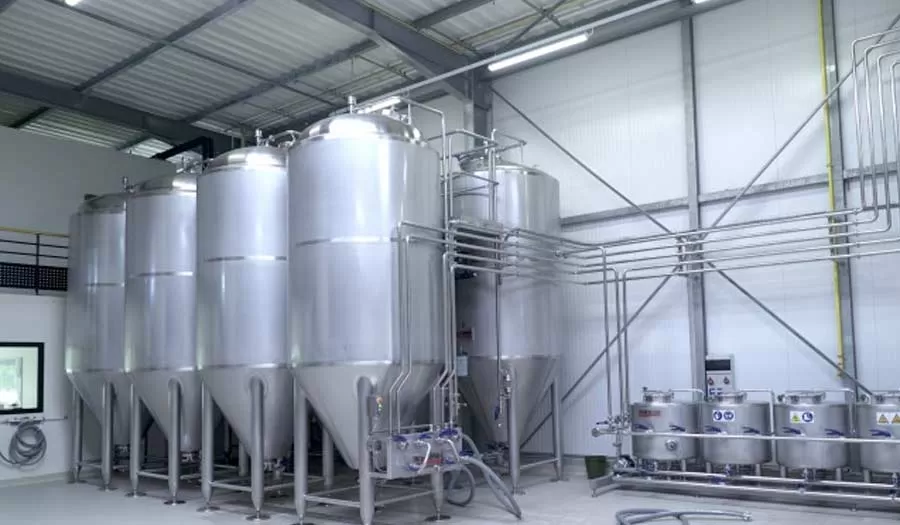In the beer brewing process, each step is a critical component. Allows you to achieve the desired flavor, aroma, mouthfeel and clarity in your brew. One of the most important decisions you will have to make in brewing beer is which fermentation vessel you will use. Beer fermentation tanks are essential equipment for breweries to ferment and age beer. The quality of the beer produced depends on the fermentation process and having the right fermenter is essential to achieve the desired result. In this article, we will discuss how to choose the right beer fermentation tank equipment.
Fermentation tank
A fermenter is a container into which the wort is poured after it has cooled to begin primary or secondary fermentation. Different styles of fermenters will enjoy different scenarios. Every brewer has a different end goal, and whether it’s trying a small-scale experimental homebrew or starting a brewery, every brew is a new experience.
What size primary fermenter do I need
In the early stages of fermentation, a thick layer of foam, known as krausen foam, develops on top of the wort. The krausen helps protect the fermenting wort from infection and is a good indicator of how things are going. The amount of Claussen decreases as the fermentation ends.
If you want to fill your fermentation vessel with wort. Krausen would have nowhere to go and would be blown out through a blocked airlock.
To prevent this from happening, you should choose a fermenter that is 20% larger in volume than the beer you are brewing. This leaves an empty space at the top of the fermenter called the headspace.
Most homebrew recipes are designed to produce 5 gallon batches of beer and must 6 gallon or 6 half gallon fermenters.
What size secondary fermentation do i need
After fermentation is complete, you can bottle or barrel the beer, or transfer it to a second vessel for aging. More hops, spices, and other ingredients can also be added at this stage.
Unlike primary fermenters, primary fermenters must more headspace to form Claussen. The secondary fermenter should be as full as possible. This minimizes the amount of air exposure and reduces the chance of the beer being oxidized and developing unwanted off-flavors.
For a 5 gallon batch, you will need a 5 gallon secondary fermenter.

Fermentation Tank Material
The material of the fermenter is an important consideration in choosing a beer fermenter. The most used materials for beer fermenters are stainless steel, aluminum and plastic. Stainless steel is the most popular choice because it’s durable, easy to clean, and won’t react with beer. Aluminum is also a good choice as it is lightweight and affordable. Plastic tanks are less expensive than metal tanks, but they may not be as durable and difficult to clean as metal tanks.
Tank size
The size of the fermenter is another key factor to consider. The size of the tank should be appropriate for the size of your brewery and the volume of beer you intend to produce. Smaller breweries may need tanks with a capacity of 5 to 10 barrels, while larger breweries may must tanks with a capacity of 30 to 50 barrels or more.
Cooling system
The cooling system of the fermentation tanks is another important consideration. The cooling system should be able to maintain the temperature range required for the fermentation process. Most fermenters have cooling jackets that allow glycol to circulate through the tank to regulate temperature. Other tanks may have a built-in cooler or an external cooling system.
Pressure Level
The pressure rating of the fermenter is another important consideration. Tanks should be able to withstand the pressures created during fermentation without compromising the integrity of the tank. Pressure ratings are usually measured in pounds per square inch (PSI), and the tank should be rated for the type of beer you intend to produce.
Accessories
The accessories that come with your fermenter can also affect its suitability for your brewery. Some jars come with more accessories such as thermometers, pressure gauges or sampling ports, which can help watch the fermentation process. More accessories may include manholes for easy access to the tank, support arms or sight glasses.
To sum up, choosing the right beer fermentation tank equipment is very important for the production of high-quality beer. When choosing a beer fermentation tank, factors such as tank material, size, cooling system, shape and design, pressure rating and accessories should be considered. Using suitable fermenter equipment can achieve the ideal fermentation effect and improve the quality of beer.




